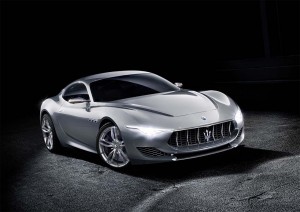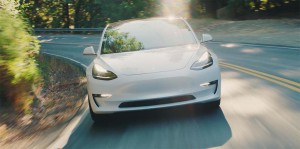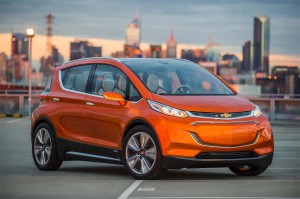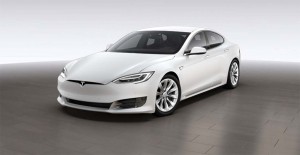
Automakers are planning to launch as many as 400 electrified vehicles by decade's end, including an all-electric version of the upcoming Maserati Alfieri.
After a painfully slow start, sales of electrified vehicles finally seem to be gaining some desperately needed traction, a new study suggesting global sales of hybrids, plug-ins and pure battery-electric vehicles will reach 1.6 million this year, a 25% increase from 2017.
The shift comes at a critical time for the auto industry considering even manufacturers like Fiat Chrysler Automobiles, long skeptical of battery-based technologies, are ramping up production plans. About 165 models are already available in various markets worldwide, according to the study by London-based ReportBuyer, and that will grow to “more than 400 models” by 2025.
“If all the announcements made so far were to come true, there will be about 25 million EVs sold by 2025 or 20% of all cars sold would be EVs,” the electrified vehicle study forecast. While that includes a mix of different products, many of which combine gas and electric powertrains on one platform, other studies have forecast that BEVs alone could account for 20% of the total world vehicle market by 2030.
Several factors appears to be helping drive demand, including tough new emissions and mileage regulations, improved range, falling prices and a rapid expansion of the public charging network. The charging stations market, according to a second ReportBuyer study, will surge from an estimated $5.3 billion this year to $30.4 billion by 2023.
(FCA planning to plug in. Click Here for the story.)
Worldwide, the first of the ReporrtBuyer studies notes that China is leading the charge with a 48% share of total sales. That’s no surprise considering that country now views battery technology as a critical tool in its effort to reduce endemic smog problems. Recently enacted regulations are expected to yield significant increases in sales of plug-based models, in particular.
Europe currently holds a 26% share. And there, demand could surge in the coming years, as tougher regulations go into effect. A number of countries, including Germany, are cracking down on the diesels that have long been seen as a way to reduce fuel consumption and CO2 emissions. Norway, meanwhile, is the first European country to enact an outright ban on sales of vehicles using internal combustion engines, starting in the middle of the coming decade. And several other countries, including the UK, France, and even Germany, are considering similar moves.
The U.S. ranks number three in the sales charts — with all forms of battery-based models accounting for a mere 3% of new vehicle sales in 2017. And it is uncertain how fast demand will grow. Though it has also begun surging at double-digit levels, that could be short-circuited by the Trump Administration which, last week, took the next step towards rolling back the strict Corporate Average Fuel Economy standard enacted by the Obama Administration.
But some manufacturers have said they expect to make few changes to their plans, even if the proposed CAFE revision survive the expected legal challenge, in part because of shifting consumer demand, as well as the likelihood that the rules could be reinstated if a Democrat reclaims the White House in 2020.
At the moment, conventional hybrids are the top sellers among electrified models, but among plug-based vehicles, all-electric models are outselling plug-in hybrids. Tesla, in particular, help three of the top five sales spots among plug-based vehicles for the first four months of 2017, led by the California automaker’s new Model3.
(Click Here for details about the new Tesla hypermiling records.)
Through the end of April, Tesla delivered 12,055 Model 3 battery-sedans, compared to the second-ranked Toyota Prius Prime, with sales of 9,094. The Tesla Model S was third, with 6,550 sold, followed by Chevrolet’s Bolt EV, at 5,650, and the Tesla Model X wrapping up the top five with sales of 5,525.
If anything, Tesla’s sales have been severely restricted by ongoing problems with the company’s Gigafactory battery plant in Reno, Nevada – which is currently operating at barely 35% of planned capacity, according to company data – and the Tesla assembly plant in Fremont, California.
That factory has faced what CEO Elon Musk has described as “production hell” since the Model 3 launched in July 2017. The company originally hoped to produce about 400,000 of its first mainstream models this year but managed to get output up to barely 2,000 a week as of the end of the first quarter. It has now set a goal of reaching 6,000 a week by the end of the second quarter or early in the third.
But the longer it takes, analysts warn, the more likely Tesla will face serious competition from 11 carmakers who have announced major EV programs. Just last week, FCA announced plans to roll out 30 electrified models during its next five-year cycle, including hybrids, plug-ins and BEVs. Those models will range from a new version of Its all-electric Fiat 500 to a 700-horsepower plug-in hybrid Alfa Romeo supercar.
The upbeat ReportBuyers study forecasts that one reason for growing demand will be that EVs “are likely to cost the same as conventional cars by 2020 which will be a huge threat to the conventional car industry.”
Perhaps, but FCA CEO Sergio Marchionne last week warned that automakers will still have to subsidize their products, the Euro-American automaker expecting that over the next five years it will only be able to recover 60% of the premium required to switch from IC engines to electric propulsion.
(To see more about how dealers are hampering EV sales, Click Here.)
A Boston Consulting Group study released last December estimated that the factory cost for battery-based propulsion systems will continue falling in the coming decade, but that price parity likely don’t be reach until 2025, at the earliest.



